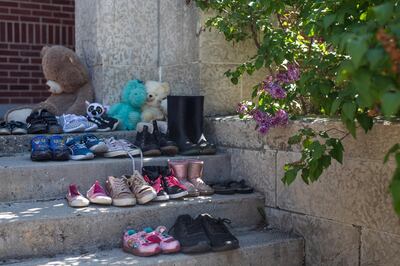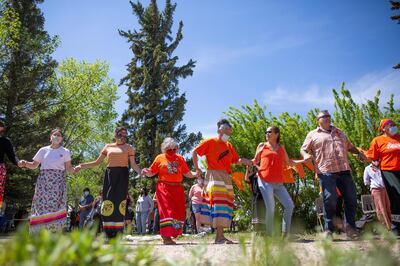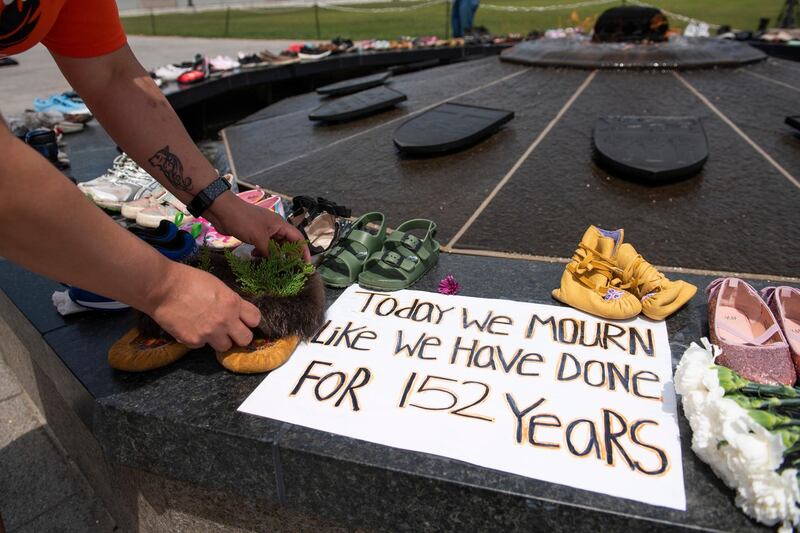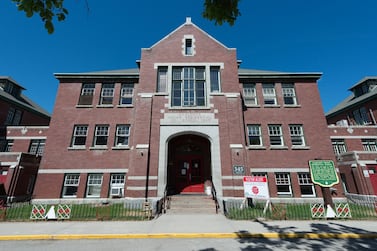Stewart Gonzales still remembers his first day at St Paul's Indian Day School in North Vancouver, British Columbia, in 1966.
Mr Gonzales, an indigenous Canadian and member of the Squamish Nation, was 5 years old when the Canadian federal government forced him to attend the church-run school.
His teacher asked him to count to 10 in English, a language he did not yet know. He said that when he could not, he was beaten with a leather strap.
"The principal and three other nuns took turns whipping my hands with a leather strap until my hands were bloody," Mr Gonzales told The National.
The damage was so severe he couldn’t hold his own utensils for weeks. “The skin on my hands was ripped open from the leather strap," he said.
This was the first in a litany of painful experiences Mr Gonzales, now 60, was forced to endure at the school.
Mr Gonzales said his childhood memories are never far from his mind, but he has been particularly focused on them since last month's horrifying discovery of the remains of hundreds of children in Kamloops, British Columbia.
“It's been a very challenging week. I’ve been crying off and on, sobbing, angry, upset,” Mr Gonzales said.
In May, the Tk'emlups te Secwepemc First Nation announced they discovered the bodies of 215 children at what was once the Kamloops Indian Residential School.
“We have this unthinkable loss that was spoken about but never actually documented,” Rosanne Casimir, chief of the Tk’emlups te Secwepemc First Nation, told the Canadian Public Affairs Channel.
The school operated from 1890 to 1969 and was for a time the largest Indian residential school in the country, with more than 500 pupils.
The discovery of the unmarked graves shocked the country. Canadian Prime Minister Justin Trudeau said in a tweet that the discovery "breaks his heart".
The news that remains were found at the former Kamloops residential school breaks my heart - it is a painful reminder of that dark and shameful chapter of our country’s history. I am thinking about everyone affected by this distressing news. We are here for you. https://t.co/ZUfDRyAfET
— Justin Trudeau (@JustinTrudeau) May 28, 2021
Chief Casimir said the Tk’emlups te Secwepemc First Nation had long known about the missing children, but recent advancements in ground-penetrating radar made the discovery possible. None of the bodies have been exhumed and the causes of death are unknown.
For more than 100 years, starting in the 1800s and continuing on until the last residential school was closed in 1996, the Canadian government operated a large network of schools designed to forcibly assimilate the country's indigenous peoples.
Children were taken from their homes, without their parents’ permission, and dropped at boarding schools where they were not allowed to use their native languages. Punishments were often severe and sexual abuse was rife.
For decades, the federal government and much of Canadian society ignored the horror stories coming from these schools, but in 2008, the federal government launched a National Truth and Reconciliation Commission.

The commission, which ran for about seven years, provided an opportunity for residential school survivors to share their stories publicly.
The commission published a report that said what transpired at Canada’s residential schools amounted to a “cultural genocide".
The National Centre for the Truth and Reconciliation Commission, which operates as the commission's archives, estimates that more than 4,100 children died or went missing while attending residential schools across Canada.
“There were 139 schools that were identified and the mortality rate of these schools was disproportionately high,” said Raymond Frogner, head of the commission archives.
“I would anticipate that it will be discovered in other places and in most schools. I think we'll have something of this nature.”
Mr Gonzales, who attended two different residential schools, said that even as a child, he was aware that pupils were disappearing and every time someone went missing, it made him wonder “what would happen if that was me?"
It took Mr Gonzales decades to recover from the trauma inflicted on him. For years, he said he used alcohol and other substances to numb the pain.
His story mirrors those of other residential school survivors.
The Kamloops discovery has aggravated old wounds, but Mr Gonzales hopes it also serves as another opportunity for people in Canada to fully acknowledge the pain caused by residential schools.
“All of us as Canadians have an obligation and a responsibility to understand the true history of our country, '' said Bradley Baker, Mr Gonzales's nephew.

Mr Baker, an educator in North Vancouver, said education was key to moving forward.
Each province has its own curriculum. The history of residential schools is now included in the curriculum of every province and territory, but it is not mandatory everywhere and the lessons vary in their extensiveness.
"We want pupils to have conversations with their parents when they get home on what they're learning so the parents can also start to learn about who we are and where we're going with Canada," Mr Baker told The National.
For Mr Gonzales, the pain is inescapable, but he insists on sharing his story so people in Canada can learn and understand the country’s history.
“My goal is that nothing like this would ever happen again. I know there are going to be more findings throughout the residential schools across Canada, because this is just the tip of the iceberg,” he said.








